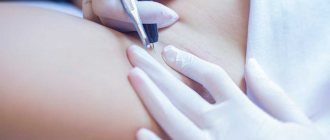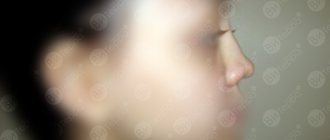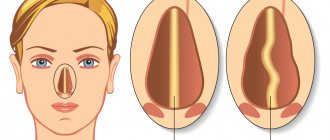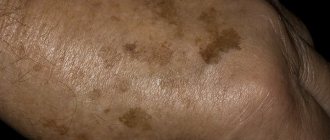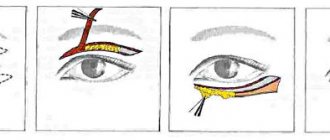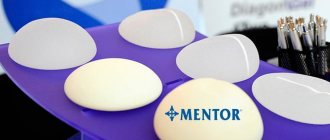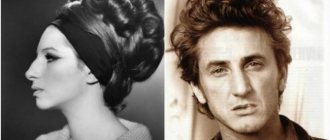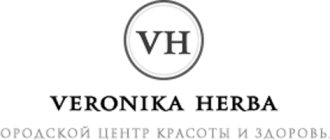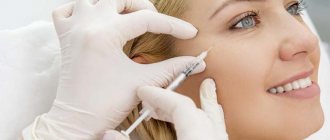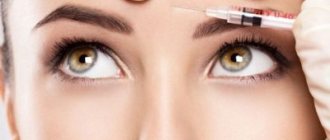Nature rarely gives people ideal facial features. And if 20-30 years ago correcting one’s appearance was not only very expensive, but also quite dangerous due to the high risk of possible complications, today plastic surgery makes it possible for almost any person to correct congenital or acquired defects in appearance.
Rhinoplasty of the tip of the nose can be performed as an independent operation aimed at changing this particular area, or performed in combination with other correction methods (for example, with septoplasty, a procedure performed to straighten the nasal septum).
What is nasal tip rhinoplasty?
Tip correction is the most common type of rhinoplasty. The operation allows you to eliminate asymmetry, remove sagging columella, reduce an overly rounded nose, lift drooping ones or narrow a wide one. With rhinoplasty of the tip of the nose, the doctor can only adjust the patient’s soft tissues or remove part of the too voluminous cartilage.
To achieve the desired effect from the procedure, it is important to choose the right plastic surgeon: study his portfolio and, if possible, communicate with former patients. After all, an unsuccessful operation often becomes the cause of pronounced asymmetry and other serious defects, and excision of too large a volume of tissue does not allow re-correction and correction of the deformed area.
Modern techniques
On the website of the Correct Clinic you can find detailed information about all types of rhinoplasty of the nose, as well as see the results of plastic surgery of the tip of the nose in the photo before and after the operation performed by our specialists.
There are quite a few types of rhinoplasty; which technique will be used depends on the desired result. Each patient receives an individual approach, so in our center not a single procedure is performed according to absolute standards.
To correct the tip of the nose, the following techniques are used:
- grafting - used when it is necessary to increase the volume of the tip of the nose by installing a cartilage graft;
- reconstruction - used to eliminate defects resulting from previous rhinoplasty.
Regarding the methods of performing the operation, plastic surgeons use two methods: laser and instrumental (scalpel). Rhinoplasty of the tip of the nose using the laser method has many advantages, including painlessness, bloodlessness and absence of scars, even with open access. But it is not always possible to use a laser, so surgery using a scalpel still remains relevant.
Correction of the tip of the nose: varieties
A nose of ideal shape and size must meet two main parameters:
- The nasolabial angle should be 90-120⁰;
- The ratio of the height of the tip and the length of the back is 0.67 to 1.
At the same time, the size of the nostrils also plays a significant role for aesthetic perception: their length should be ⅔ of the total length of the lower part of the nose.
Of course, only a few people have ideal parameters. For the rest, to obtain ideal facial proportions, correction of the tip of the nose is often required.
In each specific case, the correction method, as well as the surgical technique, is selected individually in accordance with the physiological characteristics and condition of the patient’s tissues.
Round and wide shape
The ideal nose has a triangular base. If the tip is rounded or U-shaped, surgical correction is required. During surgery, the surgeon places the main emphasis on the cartilaginous domes in order to reduce the distance between them. This procedure allows you to lengthen the tip of the nose and narrow its width.
To achieve a more noticeable effect, the wings of the nostrils are also hemmed (this visually changes the size and makes them more accurate).
If the cause of the defect is a too massive nasal dorsum, then correction of the soft tissues is combined with osteotomy - changing the shape and size of the osteochondral part by excision or artificial fracture.
Large and long nose tip
Reducing the size of the lower part of the nose is achieved by narrowing the “supporting” elements. To do this, the following manipulations are carried out:
- The position of the middle legs of the cartilage changes;
- The lateral legs are dissected or shortened;
- The size of the wings decreases.
The last intervention is mainly done to ensure that the reduction of the nasal apex does not entail stretching and increasing the length of the nostrils.
Drooping nose tip
There may be several reasons for this defect:
- Genetic characteristics;
- Age-related changes;
- Consequences of unsuccessful rhinoplasty.
But the correction method will depend not on the reasons that led to this deficiency, but on the condition of the patient’s tissues. You can correct a drooping nasal tip in one of several ways:
- Partial removal of cartilage tissue and moving the rounded edge of the cartilage upward;
- Moving the lower part of the cartilage closer to the base of the nose;
- Resection of the inner part of the muscle tissue.
To achieve a stable result and eliminate the risk of tissue displacement, the operation is performed in an open manner.
Forked form
The most common cause of this defect is that the dermal layer at the tip of the nose is too thin. Eliminate this deficiency in one of two ways:
- Stitching of cartilage tissue, which leads to lengthening of the middle stalk of the cartilage;
- Transplantation of the patient's cartilage tissue into the problem area.
Also, during the operation, the dermal or muscle layer may be excised or redistributed.
Upturned nose
A snub nose visually looks shorter and draws undue attention to the nostrils. To lower the upturned tip, special implants are used that are installed in the dorsum of the nose. To achieve a better result, it may be necessary to reduce the wings or narrow the nostrils. The final effect after surgery will be noticeable after 6-8 months.
Crooked nose tip
The main cause of this defect is trauma, as a result of which the cartilage tissue of the nose was damaged. The tip is straightened and the symmetry of the nostrils is restored, mainly through the transplantation of special silicone implants or the patient’s own tissues processed to the desired size. The same method is used to widen the narrow tip of the nose.
Visual deformation of the nose
Visual deformation of the nose, if it is not severe, is often ignored by a person, which is why the negative consequences of existing problems with nasal breathing begin to develop. There are several types of nasal deformities, each of which has its own characteristics. The cause of deformation is not always established.
Classification
First of all, there are groups of deformities - congenital and acquired.
Congenital defects of the external nose include:
- agenesis - a condition in which complete underdevelopment of the nose is revealed;
- hypogenesis – pronounced underdevelopment of the nose, but with the presence of its main components;
- persistence – preservation of the embryonic structures of the nose after birth. It is a deformity for both children born on time and those born prematurely;
- dysgenesis – abnormal development of the nose;
- hypergenesis - a condition in which organ tissue grows excessively, leading to significant external deformity;
- Dystopia is a violation of the position of the nose on the face.
Congenital pathologies in children can be a double or cleft nose, as well as an organ that is divided into two halves or consists of one or two proboscis. The type of pathology is determined immediately.
Traumatic visual deformations of the organ are also divided into several types. This classification looks like this:
- deformation of soft tissues - in this case only their appearance is disturbed and, as a rule, nasal breathing is not impaired. The problem is primarily cosmetic;
- damage to cartilage tissue – often observed with direct blows to the nose. In this case, the cartilage is torn off or seriously deformed. Normal nasal breathing is not always maintained, so its adjustment is often required;
- deformation of bone tissue is the most severe injury in which the integrity of the bones of the bridge of the nose is damaged, which causes its deformity and disrupts normal breathing through the nose;
- complex deformation is the most severe form, when all tissues are damaged - from soft to bone. With such a violation, several surgical operations may be required to eliminate the problem, during which the structures will be gradually restored. This damage is not only difficult to repair, but also leaves significant deformities.
After the first examination, the doctor determines the degree of deformation of the external nose and prescribes further examination, if required. When there is no need to further investigate the disorder, the surgical method that will be most effective is selected.
Which deformities are most often acquired?
After an injury, in most cases, the nose appears bent or dented in the cartilage area. Since the nose is the most prominent part of the face, its deformities are the most common among all facial injuries. Most direct blows to the face fall precisely on the nose, on its tip, which damages the cartilage and soft tissues. If in such a situation treatment is not carried out urgently, then a visible permanent deformation occurs, the correction of which after healing of the injury is only possible through surgery.
The most common problem with the nose is when cartilage pulls away from the skull bone, causing the cartilage to become misaligned. As a result, the lower half of the nose is shifted. If a complete tear does not occur and the cartilage only sags, then a depression appears in the area where it connects to the bone and some hump appears.
Tumors as visible deformation of the external nose
Neoplasms also refer to visible deformations of the external nose. They can cause disturbances in its shape both when located outside and when located in the nasal cavity. Most neoplasms are benign in nature. The most common of them are polyps, nerve fiber tumors, fibromas, papillomas and adenomas.
Internal formations, even before the appearance of external deformation of the nose, are manifested by impaired nasal breathing. Next, bloody discharge occurs and, lastly, an external change in the external nose, which may become asymmetrical, curved, or change its color to painful red or bluish. Also, with a significant tumor size, tissue compression may occur, which will reduce their nutrition and necrosis may develop, which leads to the appearance of an ulcer.
Benign neoplasms with timely treatment do not pose a danger and are removed surgically. In rare cases, they are destroyed using low temperatures. If necessary, additional therapy is carried out to restore the normal appearance of the deformed part of the nose.
Malignant tumors are not very common. The most common of these are squamous cell carcinoma and glandular carcinoma. Depending on the location of the tumor, it can lead to visible deformations of the nose, which in some cases are the first symptom of a dangerous condition. With such a lesion, the nose begins to increase in size on the side of the tumor, and the color of the skin on it may change. Treatment is carried out depending on the patient’s condition, and its main task in such a situation is no longer to restore the normal appearance of the nose, but first of all to stop the malignant process and eliminate the risk of its spread to surrounding tissues.
Alternative methods of nose tip rhinoplasty
Modern plastic surgery offers not only surgical correction methods. Non-surgical methods are also used to eliminate some defects, but they correct only minor problems and are not suitable for serious correction.
- Rhinoplasty with Aptos threads. The technique is suitable for raising the tip of the nose and adjusting the wings. The threads are inserted under the skin through small punctures and allow the tissue to be moved to the desired position. Recovery after plastic surgery takes no more than 2-3 days.
- Injection plastic surgery. To increase the volume of the problem area, special fillers are used: autologous (the patient's own fat cells), absorbable drugs and biodegradable compounds. To maintain the effect, injections must be done every 8-12 months.
Cost of rhinoplasty
The cost is determined by the complexity of the intervention, the technique used and the type of anesthesia. To find out how much it costs to fix your nose and get a more detailed consultation, request a call back or call +7.
Our administrators will answer all your questions and make an appointment with a specialist.
Even more results in
this section of the site.
Examples of works by Anzhelika Vladimirovna Nikolaeva-Fedorova and Levan Leonidovich Valiev.
Contraindications
Rhinoplasty has absolute and relative contraindications. The absolute ones include:
- Oncological diseases;
- Hemophilia and other disorders of hemostasis;
- Disturbances in the functioning of the cardiovascular and endocrine systems;
- Severe mental disorders;
- HIV, syphilis and viral hepatitis;
- Tuberculosis;
- Pregnancy and lactation.
Correction of the tip of the nose is not carried out in all specific conditions of the body in which any surgical intervention is contraindicated in principle (except for operations performed for health reasons). Rhinoplasty is also prohibited for:
- Epilepsy (high risk of mechanical damage to the operated tissues);
- Bronchial asthma (increases the risk of complications);
- Autoimmune pathologies of connective tissues (the likelihood of scar formation and calluses increases).
Relative contraindications are acute infectious diseases and inflammatory processes on the skin in the area of surgical intervention. Surgical correction of the nose can be performed after treatment of these problems.
Indications and contraindications for rhinoplasty
The rhinoplasty procedure will help restore the correct shape and functions of the nose that were disrupted during prenatal development or as a result of various diseases, as well as injuries received during life: thermal, chemical, mechanical.
There are no strict medical indications for surgery. If the patient is dissatisfied with the shape of his nose or it is not functioning properly, you can voluntarily contact a plastic surgeon, explain the problem, and the specialist will select the most effective correction method, taking into account individual characteristics.
Rhinoplasty, the cost of which at the Medial clinic is available to any patient, allows you to eliminate various aesthetic and functional defects:
- saddle shape;
- pronounced hump;
- thickened or forked tip;
- dilated nostrils;
- “eagle beak” effect;
- disproportionate size and shape in relation to the face;
- breathing problems;
- deviated nasal septum.
As for contraindications, it is worth noting that the procedure is not prescribed for pregnant and lactating women. There are also medical contraindications in which plastic surgery is fraught with serious complications. These include:
- diseases of the hematopoietic system (relative contraindication);
- chronic cardiovascular diseases;
- oncological disease of any localization;
- renal, liver, heart failure;
- recent heart attack, stroke;
- infectious processes in the acute stage;
- congenital or acquired immunodeficiency (relative contraindication);
- severe mental illnesses and disorders (relative contraindication);
- pregnancy, breastfeeding.
Preparation for nose tip rhinoplasty
Before the planned correction of the tip of the nose, you will have to undergo a number of mandatory tests, including:
- General urine analysis;
- General and biochemical blood test;
- Comprehensive study of blood clotting;
- Blood to determine the group and Rh factor;
- Tests for HIV, viral hepatitis and syphilis;
- ECG with interpretation;
- Fluorogram of the chest organs;
- CT scan of the paranasal cavities.
Also, before rhinoplasty, additional examination by an ENT specialist may be required.
Recommendations before surgery
It is recommended to start preparing for plastic surgery at least a week before the procedure:
- Quit alcohol and smoking;
- Do not visit solariums and protect your skin from direct sunlight;
- Eliminate spicy, fatty and smoked foods from your diet;
- Normalize sleep patterns.
A few hours before surgery you should stop eating and drinking. The attending physician will inform you of the exact period of restrictions at the initial consultation.
Open
Open rhinoplasty differs in technique from closed rhinoplasty. An incision is made on the bridge between the nostrils. Then, the surgeon lifts the skin, removes cartilage tissue with instruments, displaces the bones, and then stitches the cartilage and lowers the skin to its original place.
The advantages of the method are that “openness” simplifies the doctor’s work and allows him to monitor the patient’s condition at all stages of the operation. But this also results in two main disadvantages - the formation of a visible scar and prolonged swelling due to damage to the columella.
Rehabilitation period
The final effect after surgery will be noticeable after 6-8 months, when swelling has completely subsided and new connections between tissues have formed. During this time, you need to protect your nose from any mechanical damage and not expose it to direct sunlight.
- You can eat and drink 3-5 hours after correction. You can only eat soft food at room temperature.
- After 4-5 days, swelling and hematomas will begin to subside. Until this time, painful sensations may persist. For severe pain, the doctor will prescribe painkillers.
- For 1-2 weeks you should limit physical activity, do not smoke or drink alcoholic beverages.
- For a month it is forbidden to visit baths and saunas, take a bath or take too hot a shower.
- For 6-8 weeks, you should not swim in pools or open reservoirs, or stay in places with too cold or hot air.
During the rehabilitation period, it is important to strictly follow the surgeon’s recommendations. This will eliminate the possibility of side effects and accelerate tissue regeneration.
Rehabilitation after rhinoplasty
After all surgical procedures, tampons are installed in the nasal passages, which can be removed only after 2–3 days. The new shape of the nose is fixed with a plaster cast. When performing surgery on the cartilaginous part of the nose, such a sticker must be worn for 5–7 days. When performing manipulations on the bone, the onlay is worn longer - 12 - 14 days.
The pain after surgery is moderate; to alleviate the condition, the doctor may prescribe a painkiller. In the first days, due to severe swelling, breathing problems may occur. It is not recommended to wear glasses for 1.5 months after rhinoplasty. The full course of rehabilitation lasts on average 6 – 8 months, so the final results of the procedure can be assessed six months to a year after the operation.
Complications after rhinoplasty
Surgical intervention to correct the tip of the nose requires pinpoint precision from the surgeon. Improper operation, as well as non-compliance with medical recommendations, can lead to the following complications:
- Infection of damaged tissues;
- Seam divergence;
- Deformations of the osteochondral base;
- Excessive drooping or severe upturning of the tip.
If the result is unsatisfactory, re-correction can be done no earlier than 1-1.5 years after the initial plastic surgery.
Prices for nose surgery
| Name of service | Price |
| Complex (nose surgery + consumables + anesthetic aid + hospital) | 200,000 rub. |
| Plastic surgery of the tip of the nose | 100,000 rub. |
| Plastic surgery of the nasal bridge | 90,000 rub. |
| Plastic surgery of the tip and back of the nose | 180,000 rub. |
| Nostrilplasty (on one side) | 25,000 rub. |
| Plastic surgery of the nostrils (on one side) during surgery | 20,000 rub. |
| Septoplasty (isolated operation/one of the stages) | 40,000 - 60,000 rub. |
| Bulhorn cheiloplasty (isolated operation/one of the stages) | 40,000 - 50,000 rub. |
| Consumables | 7,000 rub. |
| Anesthetic care | 15,000 rub. |
| Hospital (1 day) | 5,000 rub. |
Pricing for nasal tip surgery
In different regions of the Russian Federation, the price of nose tip correction may vary significantly. In Moscow, rhinoplasty usually costs a little more than in the regions, but more qualified and experienced doctors often work here.
In addition to the location of the clinic, the cost is also affected by:
- Reputation and professionalism of the surgeon;
- Qualification of anesthesiologist and medical personnel;
- Level of patient care in the clinic;
- Technical equipment of a medical institution;
- Drugs and materials used during surgery.
When choosing a medical institution and a plastic surgeon, you should first of all pay attention to their reputation and patient reviews. You should not be seduced by too low prices from novice doctors, since repeated correction is much more expensive and does not always give the desired result.
- Initial consultation on rhinoplasty₽3,000
- Including professional 3D modeling
- Repeated consultation on rhinoplasty₽6,000
- Primary rhinoplasty of the tip of the nose₽260,000
- Repeated rhinoplasty of the tip of the nose₽330,000
- Rib cartilage sampling₽100,000
- * The price for all plastic surgeries includes: hospital stay, general anesthesia, all subsequent dressings and examinations throughout the year.
Surgeon consultation
Features of the operation
Depending on the purpose of nose tip correction, the surgical process may vary. So, in contrast to the correction of the internal nasal septum, local anesthesia is used during tip plastic surgery, which facilitates the rehabilitation process.
Features of plastic correction of the tip of the nose also include:
- the procedure is performed after 18 years of age, but for medical reasons surgery is possible in childhood;
- It is not advisable to have plastic surgery after 55–60 years;
- the result of plastic surgery may affect nasal breathing;
- Duration of the operation is up to 1.5 hours;
- the procedure has contraindications;
- it is possible to perform the operation using the laser method;
- It is permissible to use a graft made from cartilage tissue from the patient’s ribs.
The plastic surgeon informs the patient about all the features of nasal tip rhinoplasty before the operation. Also, despite the safety of plastic surgery, complications due to the individual reaction of the body, hidden contraindications or non-compliance with recommendations cannot be completely excluded.

